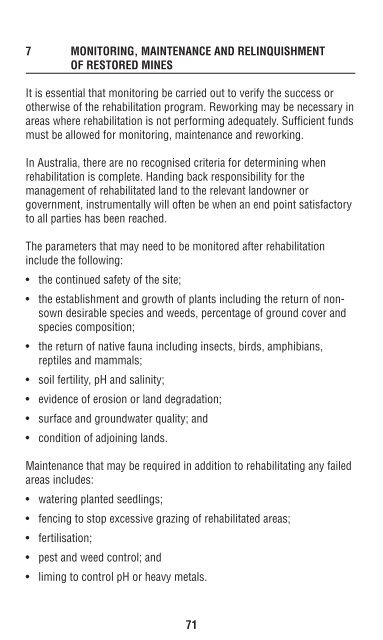Mine Rehabilitation Handbook - Mining and Blasting
Mine Rehabilitation Handbook - Mining and Blasting
Mine Rehabilitation Handbook - Mining and Blasting
You also want an ePaper? Increase the reach of your titles
YUMPU automatically turns print PDFs into web optimized ePapers that Google loves.
7 MONITORING, MAINTENANCE AND RELINQUISHMENT<br />
OF RESTORED MINES<br />
It is essential that monitoring be carried out to verify the success or<br />
otherwise of the rehabilitation program. Reworking may be necessary in<br />
areas where rehabilitation is not performing adequately. Sufficient funds<br />
must be allowed for monitoring, maintenance <strong>and</strong> reworking.<br />
In Australia, there are no recognised criteria for determining when<br />
rehabilitation is complete. H<strong>and</strong>ing back responsibility for the<br />
management of rehabilitated l<strong>and</strong> to the relevant l<strong>and</strong>owner or<br />
government, instrumentally will often be when an end point satisfactory<br />
to all parties has been reached.<br />
The parameters that may need to be monitored after rehabilitation<br />
include the following:<br />
• the continued safety of the site;<br />
• the establishment <strong>and</strong> growth of plants including the return of nonsown<br />
desirable species <strong>and</strong> weeds, percentage of ground cover <strong>and</strong><br />
species composition;<br />
• the return of native fauna including insects, birds, amphibians,<br />
reptiles <strong>and</strong> mammals;<br />
• soil fertility, pH <strong>and</strong> salinity;<br />
• evidence of erosion or l<strong>and</strong> degradation;<br />
• surface <strong>and</strong> groundwater quality; <strong>and</strong><br />
• condition of adjoining l<strong>and</strong>s.<br />
Maintenance that may be required in addition to rehabilitating any failed<br />
areas includes:<br />
• watering planted seedlings;<br />
• fencing to stop excessive grazing of rehabilitated areas;<br />
• fertilisation;<br />
• pest <strong>and</strong> weed control; <strong>and</strong><br />
• liming to control pH or heavy metals.<br />
71<br />
Rehabilitated ecosystems must be sustainable in the long-term.<br />
<strong>Rehabilitation</strong> can be considered successful when the site can be<br />
managed for its designated l<strong>and</strong>-use without any greater management<br />
inputs than for other l<strong>and</strong> in the area being used for a similar purpose.<br />
Restored native ecosystems may be different in structure to the<br />
surrounding native ecosystems, but the l<strong>and</strong> managers should be<br />
confident that they will change with time along with or towards the make<br />
up of the surrounding area. The rehabilitated l<strong>and</strong> should be capable of<br />
withst<strong>and</strong>ing normal disturbances such as fire or flood.<br />
While the criteria for assessing whether an ecosystem developing on a<br />
rehabilitated site is sustainable in the long-term have not been fully<br />
developed, the issue continues to be a key subject of industry research.<br />
A large number of ‘vital ecosystem attributes’ that may serve as<br />
indicators of ecosystem structure <strong>and</strong> function have been suggested.<br />
Components of the success criteria could include:<br />
• physical (stability, resistance to erosion, re-establishment of<br />
drainage);<br />
• biological (species richness, plant density, canopy cover, seed<br />
production, fauna return, weed control, biomass productivity,<br />
establishment of nutrient cycles);<br />
• water quality st<strong>and</strong>ards for drainage water; <strong>and</strong><br />
• public safety issues.<br />
Ecosystem Function Analysis (EFA), a methodology developed by<br />
researchers from the CSIRO to provide indicators of rehabilitation<br />
progress, has been tested on a number of different types of mine around<br />
Australia. EFA may be used widely in the future.<br />
72
















